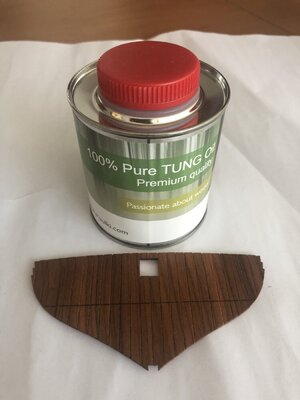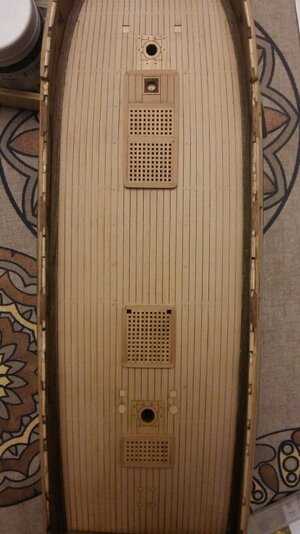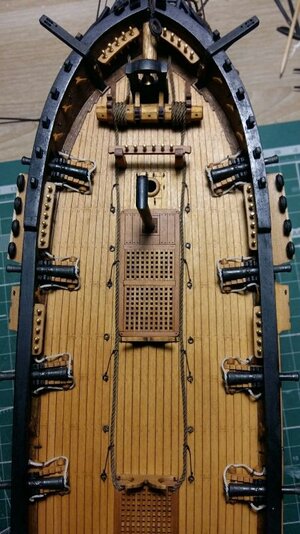Your continuing combination of an explanatory text together with the annotated illustrations and photos make this a very comprehensive build for us to follow. It looks very true to the eye. Well done. RichHello Everyone
After the bow deck planks had been installed, the end pieces for the Yuloh (rowing and steering oar) were added to both the bow and stern. The flexibility of the sampan is that it can be steered from both ends which makes it extremely maneuverable.
View attachment 245243
The red squares indicate the two platforms for the Yuloh (the steering and sculling oar). The construction of the Yuloh and its mode of operation will be discussed a little later.
PREPPING THE HULL
I could now turn my attention to sanding the hull. You will have noticed that I have not mentioned anything about that up to this point as I first wanted to make sure that the structural rigidity of the hull was good enough. With the deck planking completed and the floor in place though, the hull was as strong and rigid as anyone could wish for.
Now for interest’s sake – when I plank the hull, I do not bevel the edges of planks as they butt-up against adjoining partners. Lazy? I probably am, but that’s not the reason for not doing it.. Without beveling or chamfering, a little "lip" is created when two planks are butted-up against each other. That little “lip” that remains, provides (to me at least) the perfect angle (when viewed from the top) at which I need to sand the hull. I start by sanding cross-grain at an approximate angle of 45 degrees using "heavy artillery" 80-grit sandpaper. The Pear Wood is resilient and the 2mm thickness, meant that lots of sanding was required to remove the "lips". Once that was done, I moved down to 120-grit sandpaper and started sanding longitudinally and following the grain of the wood. Finally 360-grit was used to complete the process. The whole process was straightforward and there was nothing untoward.
YULOH
In his excellent book, "The Junks and Sampans of the Yangtze". G.R.G. Worcester wrote:
"Propulsion is by means of a single “yuloh”, or “lu”, an original and extremely efficient implement; 13 feet in length, it is scarfed in three pieces, thus forming a gentle curve. When in operation, the blade is kept very deep in the water, that is to say, 3 1/2 feet, or more than one-third of its length being below the surface, and as the face of the blade is 6 inches in width, this combination gives much increased leverage and power.
The yuloh pivots on a 3-inch bearing-pin* which ends in a knob. This pin is situated on the transom, and the loom is held in place by a coir lanyard, 5 1/2 feet long, attached to a ring-bolt in the stern deck. The hand holding the yuloh is held at head level and rather behind, while the hand on the lanyard works across the breast. It is interesting to record that the sculler can average 41 strokes to the minute under favourable weather conditions, yielding the satisfactory speed of 8
"li" (knots) per hour!
While most sampans share the exact same basic characteristics, they do, nevertheless, fall into two definite categories, known as “pang”, or groups. These are the Ning-pang, or group manned by Ningpo men, and the Soo-pang, or group manned by either Soochow men, men of Shanghai, or men from Kiangyin, a small town some 80 miles up the Yangtze.
The distinguishing feature is that in the Ningpo-owned craft the bearing-pin for the yuloh is situated on the port side, which necessitates the sculler using his left hand on the oar; while in the boats operated by Soochow, Shanghai, and Kiangyin men, the bearing-pin is on the starboard side and the sculler operates the yuloh with his right hand. The exponents of both methods maintain that theirs is the only reasonable mode of propulsion. My sampan is built according to the latter option.
*Bearing-pin: This might be confusing as it does not refer to a device which facilitates rotation, but actually means "load-bearing". In other words, it "Bears" or "carries" the Yuloh - hence me changing it the name to "load-carrying platform" and "load-carrying pin".
View attachment 245244
How the instruction manual shows assembly of the Yuloh.
View attachment 245246
The actual "load-carrying pin" and- "platform" as constructed on the model. Getting that platform to blend it seamlessly with the oar required patience. The slot provides the opening for sliding the platform over the pin.
View attachment 245247
The blade is constructed by pre-shaping two pieces of pear wood to the correct size and shape and then gluing them to either side of the oar. Interestingly, the blade and the load-carrying platform are at 90 degrees to reach other. So ... if the load-bearing platform is completely level on a horizontal plane, the blade has a 90-degree vertical angle.
View attachment 245248
View attachment 245249
The assembly on the model. In real model-life, that Yuloh is 35 cm long and the overall model length is 69 cm - so you can see that it is a substantial oar.
The picture below taken from one of Unicorn's test builds on the 4h forum clearly show the "operation" of the Yuloh and that this model was built according to the "Soochow" (Suzhou) / Shanghai style with the load-bearing platform on the starboard side of the oar and the right-hand higher up on the Yuloh - thus in the dominant position.
View attachment 245250
View attachment 245251
View attachment 245253
One of the smaller "Water-Taxi" sampans being "Yulohed" in Shanghai.
When I return for the next posting, it will be to show you the assembly and installation of the bamboo canopy.
Thank you all so much for looking, commenting, liking or just browsing.
Best regards - Heinrich
-

Win a Free Custom Engraved Brass Coin!!!
As a way to introduce our brass coins to the community, we will raffle off a free coin during the month of August. Follow link ABOVE for instructions for entering.
-

PRE-ORDER SHIPS IN SCALE TODAY!
The beloved Ships in Scale Magazine is back and charting a new course for 2026!
Discover new skills, new techniques, and new inspirations in every issue.
NOTE THAT OUR FIRST ISSUE WILL BE JAN/FEB 2026
You are using an out of date browser. It may not display this or other websites correctly.
You should upgrade or use an alternative browser.
You should upgrade or use an alternative browser.
YANGTZE RIVER HIGH-NET FISHING SAMPAN [COMPLETED BUILD]
- Thread starter Heinrich
- Start date
- Watchers 29
-
- Tags
- completed build
- Joined
- Jan 9, 2020
- Messages
- 10,540
- Points
- 938

We know the popular ships…@PT-2 Thank you Rich - you are a pillar of support and that is much appreciated. I knew from the word go that the sampan build would not be a universally popular one, but hey - who needs quantity when we have quality!
HMS Victory, Soleil Royal, Sovereign of the Seas, Royal Caroline, Wasa, San Felipe…those seem to be some of the favorites. At least the ones that get all the traffic.
The Bluenose has picked up some with the POF version, but has always been somewhat popular.
So we are here to support your obscure, unwanted, unseen, uncared for… and mostly misunderstood…what was it…oh yeah…Sampan.
Just joking…I think it’s interesting!
- Joined
- Jan 9, 2020
- Messages
- 10,540
- Points
- 938

Thank you @Dean62 Dean, I really enjoyed your comment!  and I am just as glad that you find it interesting. The sampan is actually quite a funny thing. There is SO much incredible research going into the historical accuracy of those popular subjects all in the search for "historical accuracy". And yet - everyone of those builds (and I include my Haarlem 100% in that category) relies heavily on SPECULATION and INTERPRETATION. Sampans are no longer built -and whilst the last one built was only 34 years ago, that boat was built in EXACTLY the same way as the ones that were built 300-or400-or 500-years ago. Thus with the sampan, 100% historical accuracy is possible - even right down to the exact composition and formula of the caulking that was used!
and I am just as glad that you find it interesting. The sampan is actually quite a funny thing. There is SO much incredible research going into the historical accuracy of those popular subjects all in the search for "historical accuracy". And yet - everyone of those builds (and I include my Haarlem 100% in that category) relies heavily on SPECULATION and INTERPRETATION. Sampans are no longer built -and whilst the last one built was only 34 years ago, that boat was built in EXACTLY the same way as the ones that were built 300-or400-or 500-years ago. Thus with the sampan, 100% historical accuracy is possible - even right down to the exact composition and formula of the caulking that was used!
 and I am just as glad that you find it interesting. The sampan is actually quite a funny thing. There is SO much incredible research going into the historical accuracy of those popular subjects all in the search for "historical accuracy". And yet - everyone of those builds (and I include my Haarlem 100% in that category) relies heavily on SPECULATION and INTERPRETATION. Sampans are no longer built -and whilst the last one built was only 34 years ago, that boat was built in EXACTLY the same way as the ones that were built 300-or400-or 500-years ago. Thus with the sampan, 100% historical accuracy is possible - even right down to the exact composition and formula of the caulking that was used!
and I am just as glad that you find it interesting. The sampan is actually quite a funny thing. There is SO much incredible research going into the historical accuracy of those popular subjects all in the search for "historical accuracy". And yet - everyone of those builds (and I include my Haarlem 100% in that category) relies heavily on SPECULATION and INTERPRETATION. Sampans are no longer built -and whilst the last one built was only 34 years ago, that boat was built in EXACTLY the same way as the ones that were built 300-or400-or 500-years ago. Thus with the sampan, 100% historical accuracy is possible - even right down to the exact composition and formula of the caulking that was used!As I understand the sampan as a local materials hand built working/living vessel, I am wondering if there were any "preservative" coatings applied or periodically reapplied? The same question goes to the probably frequent cleaning of the hull of growth and boring worms?? As they were a people whose entire lives were on the water I presently only imagine them as diving under and scraping the accumulation off. In the finishes perspective, how will you be "finishing" your High-Net? RichThank you @Dean62 Dean, I really enjoyed your comment!and I am just as glad that you find it interesting. The sampan is actually quite a funny thing. There is SO much incredible research going into the historical accuracy of those popular subjects all in the search for "historical accuracy". And yet - everyone of those builds (and I include my Haarlem 100% in that category) relies heavily on SPECULATION and INTERPRETATION. Sampans are no longer built -and whilst the last one built was only 34 years ago, that boat was built in EXACTLY the same way as the ones that were built 300-or400-or 500-years ago. Thus with the sampan, 100% historical accuracy is possible - even right down to the exact composition and formula of the caulking that was used!
- Joined
- Jan 9, 2020
- Messages
- 10,540
- Points
- 938

@PT-2 Rich I will be devoting a full section just on the finishing, but would nevertheless still like to answer your question. The preservative coatings that were applied all had Tung oil as the main ingredient - pure Tung oil if the Sampan boat owners were lucky enough to get it - or in lesser percentages as supply dictated. Prior to the application of the Tung oil the caulking was done and this was a process that would be repeated once a year (under ideal circumstances). Note that from 1949 when the Peoples' republic of China came into being, there was a marked shift in the behavioral patterns of the Tanka people. Since that time very few of them actually lived permanently on the water - so the sampans were regularly "beached" thus allowing the opportunity for maintenance.
@Dematosdg Daniel suggested that I apply a weathering finish to my build, but I am reluctant to do that. The weathered look of the sampan comes from many years being exposed to the elements and from repeated coatings of caulking and Tung oil. I will apply the real McCoy Tung Oil to my sampan and with time it will get darker and darker as the Tung gets re-applied. However, I suppose will never obtain a truly authentic look as the model is built from Pear whilst cedar was mostly used in the original builds.
@Dematosdg Daniel suggested that I apply a weathering finish to my build, but I am reluctant to do that. The weathered look of the sampan comes from many years being exposed to the elements and from repeated coatings of caulking and Tung oil. I will apply the real McCoy Tung Oil to my sampan and with time it will get darker and darker as the Tung gets re-applied. However, I suppose will never obtain a truly authentic look as the model is built from Pear whilst cedar was mostly used in the original builds.
I didn't realize that Tung oil was available as I have used it as a high quality hard finish on our tables and my gun stocks. Thanks, Rich@PT-2 Rich I will be devoting a full section just on the finishing, but would nevertheless still like to answer your question. The preservative coatings that were applied all had Tung oil as the main ingredient - pure Tung oil if the Sampan boat owners were lucky enough to get it - or in lesser percentages as supply dictated. Prior to the application of the Tung oil the caulking was done and this was a process that would be repeated once a year (under ideal circumstances). Note that from 1949 when the Peoples' republic of China came into being, there was a marked shift in the behavioral patterns of the Tanka people. Since that time very few of them actually lived permanently on the water - so the sampans were regularly "beached" thus allowing the opportunity for maintenance.
@Dematosdg Daniel suggested that I apply a weathering finish to my build, but I am reluctant to do that. The weathered look of the sampan comes from many years being exposed to the elements and from repeated coatings of caulking and Tung oil. I will apply the real McCoy Tung Oil to my sampan and with time it will get darker and darker as the Tung gets re-applied. However, I suppose will never obtain a truly authentic look as the model is built from Pear whilst cedar was mostly used in the original builds.
You could experiment on a test piece. First apply tung oil and let dry, then hit with 0000 steel wool, then reapply the tung oil. Repeat as many times as necessary. The steel wool will lighten the high surfaces and give it some depth and a weathered look. How much is up to you. Keep in mind the steel wool will actually polish the wood, but if you do it correctly and only hit the high surfaces, they will look like they are polished or worn with use, and the low lying areas will be rougher and thus the contrast begins.@PT-2 Rich I will be devoting a full section just on the finishing, but would nevertheless still like to answer your question. The preservative coatings that were applied all had Tung oil as the main ingredient - pure Tung oil if the Sampan boat owners were lucky enough to get it - or in lesser percentages as supply dictated. Prior to the application of the Tung oil the caulking was done and this was a process that would be repeated once a year (under ideal circumstances). Note that from 1949 when the Peoples' republic of China came into being, there was a marked shift in the behavioral patterns of the Tanka people. Since that time very few of them actually lived permanently on the water - so the sampans were regularly "beached" thus allowing the opportunity for maintenance.
@Dematosdg Daniel suggested that I apply a weathering finish to my build, but I am reluctant to do that. The weathered look of the sampan comes from many years being exposed to the elements and from repeated coatings of caulking and Tung oil. I will apply the real McCoy Tung Oil to my sampan and with time it will get darker and darker as the Tung gets re-applied. However, I suppose will never obtain a truly authentic look as the model is built from Pear whilst cedar was mostly used in the original builds.
Last edited:
- Joined
- Jan 9, 2020
- Messages
- 10,540
- Points
- 938

@PT-2 Hi Rich - the availability of Tung Oils is not a problem - it originated after all in China and in some of his writings as far back as 500 BCE, Confucius writes about Tung Oil. Since then the Chinese have put it to maritime use on their junks and sampans. (I see that some people actually call it Chinese Wood Oil - I didn't know that! In Nantong (where I live) there is a furniture manufacture who manufactures the most exquisite ancient Chinese furniture - the woodcarving, quality AND PRICE are almost impossible conceive even in your wildest dreams. They exclusively use Tung Oil and I was fortunate enough (via the Admiral's contacts) to obtain the Tung Oil that they use - claimed to be 100% pure).
- Joined
- Jan 9, 2020
- Messages
- 10,540
- Points
- 938

@Pathfinder65 Thank you my friend - you know that you are intrinsic to this build. I promise to give you lots more  fascinating information!
fascinating information!
- Joined
- Jan 9, 2020
- Messages
- 10,540
- Points
- 938

@Dean62 Dean you are very well versed in the "dark art" of Tung Oil! You are absolutely right in the use of 000-grit steel wool which is normally used to create a "polished" effect.
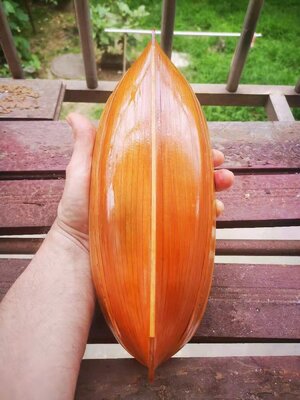

This is the hull of my Falkonet Leudo. Tung Oil and Pear Wood. I'm still mighty proud of that result, but on the Sampan I will have to create something completely different!


This is the hull of my Falkonet Leudo. Tung Oil and Pear Wood. I'm still mighty proud of that result, but on the Sampan I will have to create something completely different!
- Joined
- Jan 9, 2020
- Messages
- 10,540
- Points
- 938

OK I do apologize for the double picture - I have no idea why it did that! 
In any case, I wanted to share some pictures of the Furniture Manufacturer with you. @PT-2 @Dean62 @Pathfinder65 @Dematosdg @pianoforte @Schrader
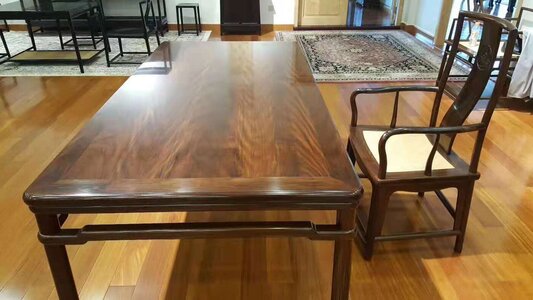
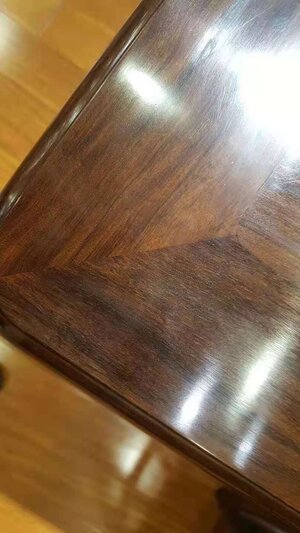
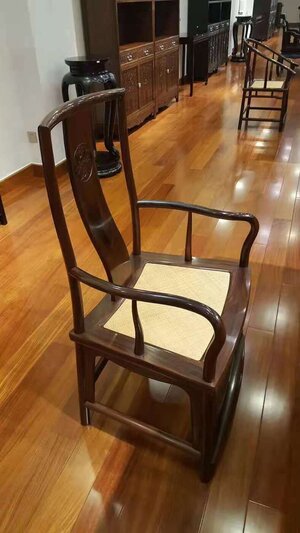
For various reasons, I sometimes struggle with my back - this chair is the most comfortable one I have ever sat in. The price for ONE chair? 280 000 RMB (44 350 USD)
Now have a look at these wood carvings:
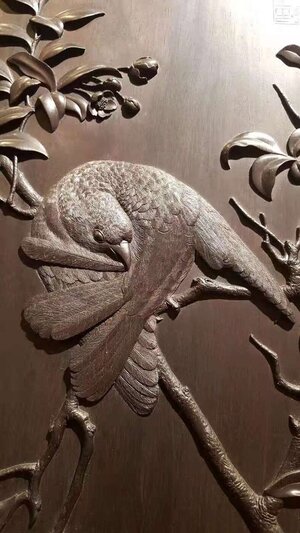
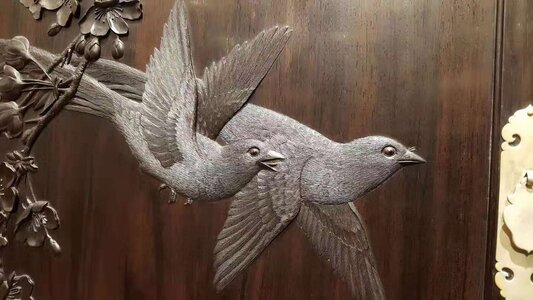
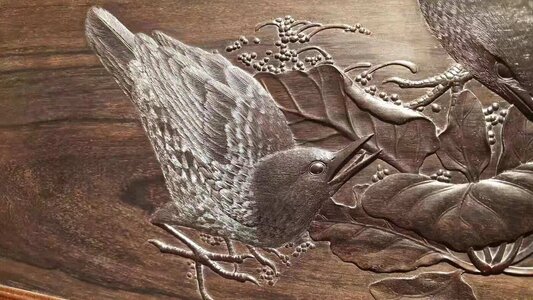
In any case, I wanted to share some pictures of the Furniture Manufacturer with you. @PT-2 @Dean62 @Pathfinder65 @Dematosdg @pianoforte @Schrader



For various reasons, I sometimes struggle with my back - this chair is the most comfortable one I have ever sat in. The price for ONE chair? 280 000 RMB (44 350 USD)
Now have a look at these wood carvings:



Love the carving! That’s serious talent, time and effort!OK I do apologize for the double picture - I have no idea why it did that!
In any case, I wanted to share some pictures of the Furniture Manufacturer with you. @PT-2 @Dean62 @Pathfinder65 @Dematosdg @pianoforte @Schrader
View attachment 245455
View attachment 245456
View attachment 245457
For various reasons, I sometimes struggle with my back - this chair is the most comfortable one I have ever sat in. The price for ONE chair? 280 000 RMB (44 350 USD)
Now have a look at these wood carvings:
View attachment 245458
View attachment 245460
View attachment 245462
It is amazing how the carved work stands above a perfectly flat surface. That would require a lot of time and precise work. Thanks, RichLove the carving! That’s serious talent, time and effort!
- Joined
- Jan 9, 2020
- Messages
- 10,540
- Points
- 938

@pianoforte Beautiful result Adi!  I am very glad that I could introduce you to Tung Oil - it has its quirks as I will point out later, but in my opinion, there is nothing to touch it. It seems to have a particular affinity for very closely-grained Pear Wood, but when it comes to the unpainted surfaces of the Haarlem, I will also use the Tung on the walnut.
I am very glad that I could introduce you to Tung Oil - it has its quirks as I will point out later, but in my opinion, there is nothing to touch it. It seems to have a particular affinity for very closely-grained Pear Wood, but when it comes to the unpainted surfaces of the Haarlem, I will also use the Tung on the walnut.
 I am very glad that I could introduce you to Tung Oil - it has its quirks as I will point out later, but in my opinion, there is nothing to touch it. It seems to have a particular affinity for very closely-grained Pear Wood, but when it comes to the unpainted surfaces of the Haarlem, I will also use the Tung on the walnut.
I am very glad that I could introduce you to Tung Oil - it has its quirks as I will point out later, but in my opinion, there is nothing to touch it. It seems to have a particular affinity for very closely-grained Pear Wood, but when it comes to the unpainted surfaces of the Haarlem, I will also use the Tung on the walnut.- Joined
- Jan 9, 2020
- Messages
- 10,540
- Points
- 938

@Alexander74 Hello Alexander. Welcome to the build log - it is great to have you here. It is just as great to see so many exponents of Tung Oil. Your deck treatment looks stunning.  It seems that before treatment you had a very light-colored Pear wood, therefore the Tung Oil gave you that beautiful golden-honey color. On the Sampan, the Pear is much darker with a strong "reddish" tint to it.
It seems that before treatment you had a very light-colored Pear wood, therefore the Tung Oil gave you that beautiful golden-honey color. On the Sampan, the Pear is much darker with a strong "reddish" tint to it.
 It seems that before treatment you had a very light-colored Pear wood, therefore the Tung Oil gave you that beautiful golden-honey color. On the Sampan, the Pear is much darker with a strong "reddish" tint to it.
It seems that before treatment you had a very light-colored Pear wood, therefore the Tung Oil gave you that beautiful golden-honey color. On the Sampan, the Pear is much darker with a strong "reddish" tint to it.Henryk, good afternoon.@Alexander74 Hello Alexander. Welcome to the build log - it is great to have you here. It is just as great to see so many exponents of Tung Oil. Your deck treatment looks stunning.It seems that before treatment you had a very light-colored Pear wood, therefore the Tung Oil gave you that beautiful golden-honey color. On the Sampan, the Pear is much darker with a strong "reddish" tint to it.
Yes, pear comes in different shades. On this model, (brigantine Phoenix), a photo of which I showed 2 pear colors. On the deck it is light, and on the hatches it is dark. And after treatment with tung oil, this is especially noticeable.



